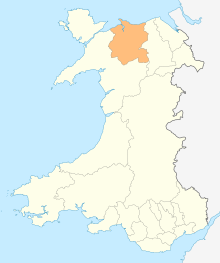Llandudno Junction railway station
Llandudno Junction railway station (Welsh: Cyffordd Llandudno) is on the Crewe to Holyhead North Wales Coast Line. The station is managed by Transport for Wales, although Avanti West Coast also serves it.
| Llandudno Junction | |
|---|---|
| Welsh: Cyffordd Llandudno | |
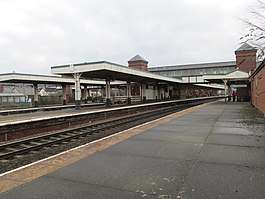 Llandudno Junction railway station (March 2018) | |
| Location | |
| Place | Llandudno Junction |
| Local authority | Conwy County Borough |
| Coordinates | 53.284°N 3.809°W |
| Grid reference | SH794778 |
| Operations | |
| Station code | LLJ |
| Managed by | Transport for Wales |
| Number of platforms | 4 |
| DfT category | C2 |
| Live arrivals/departures, station information and onward connections from National Rail Enquiries | |
| Annual rail passenger usage* | |
| 2014/15 | |
| – Interchange | 70,595 |
| 2015/16 | |
| – Interchange | |
| 2016/17 | |
| – Interchange | |
| 2017/18 | |
| – Interchange | |
| 2018/19 | |
| – Interchange | |
| History | |
| Original company | Chester and Holyhead Railway |
| Pre-grouping | London and North Western Railway |
| Post-grouping | London Midland and Scottish Railway |
| 1 October 1858 | First station opened |
| 16 June 1863 | Conwy Valley Line opened |
| 1 October 1897 | Present station opened |
| National Rail – UK railway stations | |
| |
As a junction for trains to Llandudno and the Conwy Valley Line, Llandudno Junction is the busiest station in North Wales, in terms of the frequency of services, and is also one of the busiest in terms of passenger numbers.
History
The original station (located to the west of the current station) was opened on 1 October 1858[1] and served the branch line to Llandudno. Built by the St. George's Harbour and Railway Company in 1858, this branch line heads north through Deganwy before terminating in the town. Prior to the completion of the junction station, the branch line trains from Llandudno ran through to Conwy.
This was followed by the opening of a second branch line in 1863 - the Conwy Valley Line - which headed south and was built by the Conway and Llanrwst Railway, and became part of the LNWR in 1867. It follows the valley of the River Conwy to Llanrwst (where it originally terminated) and Betws-y-Coed (a later terminus in 1869), then follows the Lledr Valley and a two mile long tunnel to terminate at Blaenau Ffestiniog, where passengers can join the Ffestiniog Railway.
Initially the Conwy Valley line ran into a separate platform on the south side of the station, and a refreshment room was built in 1864. However, the station needed to enlarge in order to cope with both mainline and branch-line traffic, and on 1 October 1897 the present station was opened[1] on a much larger site, the two island platforms offering six through lines with two bays at each end (a total of four through platforms and four bay platforms). The opening of the new station allowed for the demolition of the former station, but also entailed a diverting of the Conwy Valley branch, which now joined the mainline some half a mile further east. The old formation was used to store locomotives.
Three of the platforms on the southern side (both bays and the down loop) were taken out of use in 1968 when the easternmost of the two signal boxes was closed and the track layout altered. In 1983 the branch junction was again moved slightly eastwards to allow for a new freight terminal (now disused) to be built to replace the original goods yard and another at nearby Colwyn Bay that had been closed down prior to the start of the A55 road widening scheme the previous year.
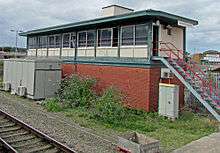
The station was also remodelled once more and resignalled at this time and in 1985 a new power signal box was commissioned at the western end,[2] which now controls the station area and junctions along with the main line between Colwyn Bay and Conwy and the northern end of the Conwy Valley branch (using the Electric Token system). The token machine for the branch is located at the station rather than in the signal box for operational convenience, allowing drivers to collect or return their token (with the cooperation of the signaller) whilst station work is undertaken rather than having to make an additional stop at the box to make the exchange.
The station was also formerly the site of a motive power depot (which closed in 1966). It was given the code 7A by the London, Midland and Scottish Railway, which was altered to 6G by British Railways in March 1952.[3] This had been located just south east of the station, and its site, together with the former adjoining goods yard, now have been redeveloped, but the new flyover road across the site bears the name 6G.
Layout
| Llandudno Junction and branches | |||||||||||||||||||||||||||||||
|---|---|---|---|---|---|---|---|---|---|---|---|---|---|---|---|---|---|---|---|---|---|---|---|---|---|---|---|---|---|---|---|
| |||||||||||||||||||||||||||||||
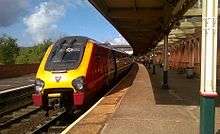
The station currently has four operational platforms:
- Platform 1 is used by eastbound trains to Chester, Crewe, Birmingham New Street, Cardiff Central, London Euston and Blaenau Ffestiniog. It is also signalled for use by trains to Llandudno.
- Platform 2 is a bay platform used by the hourly shuttle service to Llandudno. It is also used for stabling trains overnight.
- Platform 3 is a bidirectional platform which can be used by all services. It is mainly used for westbound trains, but at busy periods can be used for eastbound trains as well.
- Platform 4 is used by services to Bangor, Holyhead and Llandudno. It is also signalled for trains to Blaenau Ffestiniog (the first branch train of the day often leaves from here).
A bus shelter in the station car park is numbered as platform 5, and is used for local bus services as well as rail replacement services when the railway is closed for engineering work.
Facilities
The station is staffed throughout the day, with the ticket office on platforms 1 and 3 open from 05:25-18:25 on weekdays, 06:00-19:00 on Saturdays and 11:00-18:30 on Sundays. Self-service ticket machines are also available for use outside these times and for collecting pre-paid/advance purchase tickets. Other facilities on offer (all on platforms 1-3) include a waiting room, toilets, a cafe and public telephone. Platform 4 has a canopy and customer help point only. Train running information is provided by poster boards, digital information screens and automated announcements. Step-free access is available from the station entrance to all platforms via lifts integrated into the main footbridge that links them.[4]
Services
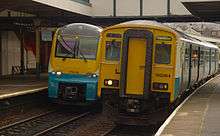
- Transport for Wales provides an hourly service from either Birmingham International or Cardiff Central to Holyhead via Wrexham General, Shrewsbury, Chester and Bangor.[5] Some morning and late evening trains run to/from Crewe.
- Transport for Wales provide an hourly service from Manchester Piccadilly to Llandudno. Since the May 2016 timetable change, several of these now run through to/from Manchester Airport. A few shuttle services between here and Llandudno also operate at certain times of day.
- Transport for Wales operate six trains per day each way on the Conwy Valley Line to Blaenau Ffestiniog.[6]As of June 2020, these services are suspended due to storm damage to the line, caused by Storm Ciara, with reopening currently scheduled for 7th September 2020.
- Transport for Wales operate one daily limited-stop Premier Service between Holyhead and Cardiff Central.
- Avanti West Coast operate a number of services from London Euston to Holyhead and Bangor. They also operate two trains on weekdays between Birmingham New Street and Crewe-Bangor/Holyhead.[7]
On Sundays services run hourly to Holyhead and Crewe (limited service to Cardiff Central and Birmingham International) on the main line, along with a half-hourly shuttle to Llandudno and there are four trains to London. There are also four trains each way on the Blaenau Ffestiniog branch (these run all year since the winter 2019 timetable change).
| Preceding station | Following station | |||
|---|---|---|---|---|
| Transport for Wales Conwy Valley Line | ||||
| Transport for Wales | Bangor |
|||
| Transport for Wales North Wales Coast Line | ||||
| Avanti West Coast London Euston-Holyhead | Bangor |
References
- Butt, R.V.J. (1995). The Directory of Railway Stations. Yeovil: Patrick Stephens Ltd. p. 145. ISBN 1-85260-508-1. R508.CS1 maint: ref=harv (link)
- Signalling Around The Junction www.6g.nwrail.org.uk; Retrieved 2010-06-09
- Walford, John (2012). A Detailed History of British Railways Standard Steam Locomotives - Volume Five: The End of an Era. Maidenhead: RCTS. p. 17. ISBN 978-0901115-973.CS1 maint: ref=harv (link)
- Llandudno Junction station facilities National Rail Enquiries; Retrieved 13 January 2017
- GB eNRT December 2019 Edition, Table 81 (Network Rail)
- GB eNRT December 2019 Edition, Table 102 (Network Rail)
- Table 65 National Rail timetable, December 2019 (Network Rail)
Further reading
- Mitchell, Vic; Smith, Keith (2010). Bala to Llandudno. West Sussex: Middleton Press. figs. 101-109. ISBN 9781906008871. OCLC 668198724.
- Mitchell, Vic; Smith, Keith (2012). Rhyl to Bangor. West Sussex: Middleton Press. figs. 41-57. ISBN 9781908174154. OCLC 859594415.CS1 maint: ref=harv (link)
- Rear, W.G. (1991). The Conwy Valley Line. Foxline Publishing.
External links
| Wikimedia Commons has media related to Llandudno Junction railway station. |
- Train times and station information for Llandudno Junction railway station from National Rail
- Greatorme.org.uk, Llandudno Junction and North Wales Train Services 1947 and 2003.
- 6G Llandudno Junction, Loco shed 6G
